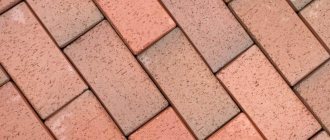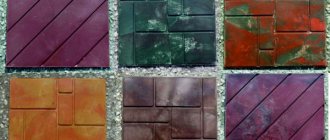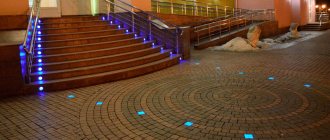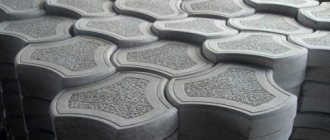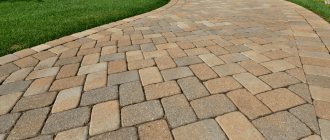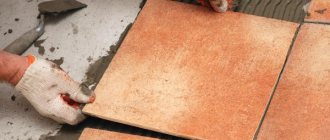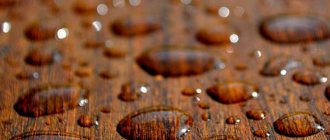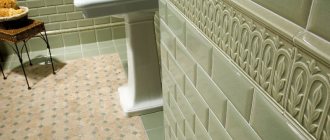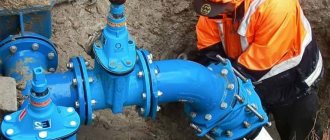On the construction market there is a huge variety of materials intended for arranging sites, paths and areas for various purposes. This niche is constantly being replenished with new models featuring improved characteristics. These materials include rubber tiles, which are used to create specialized coatings both in open areas and indoors.
Composition and production
For the production of rubber paving tiles, car tires are mainly used, which are subject to recycling. It is from them that crumb rubber is obtained, to which a special polyurethane-based adhesive composition and non-toxic pigment dyes are added that are highly resistant to fading.
Rubber tiles are manufactured using different technologies. The main raw material is crumb rubber. Crumbs are obtained by grinding car tires in special crushers (https://ural-zko.ru/product/drobilno-sortirovochnoe-oborudovanie/drobilki/rotornaya-drobilka/).
The methods for molding rubber tiles are the vibration casting method and the vibration pressing method (hot or cold). The result is an original paving slab with a thickness of 3 to 10 cm, which has a lot of advantages. But, like any other building material, the products have some disadvantages. Knowing the positive and negative aspects of modern rubber coating, it is easier to decide on the choice of the right material.
Advantages/disadvantages of rubber tiles
Due to a number of advantageous features relative to traditional types of arrangement of house buildings, playgrounds, recreation areas and other areas, the demand for rubber tiles is constantly increasing, which in the near future may lead to a reduction in the cost of this material.
Advantages:
- aesthetic appeal - due to the variety of shapes, sizes, and shade spectrum, which allow you to create intricate configurations when laying tiles;
- anti-slip effect - achieved due to the roughness of the front layer, preventing injury from an accidental fall both in winter and summer;
- the high density of the material has a positive effect on resistance to negative environmental influences, mechanical damage and wear resistance;
- high-quality dyes used during the production of the product prevent fading of the colored layer under the influence of ultraviolet rays;
- frost resistance of rubber does not require dismantling the coating in winter, since the tiles do not crack or begin to crumble even at -40°C;
- resistance to various oils, reagents and other chemicals significantly expands the range of use of tiles;
- the biological resistance of the material prevents the formation of mold on the surface of the tile, as well as fungi of various origins;
- the low porosity of the coating prevents the penetration of moisture into the structure and the formation of puddles, since water flows into the space between the tiles without lingering on the surface;
- high elasticity of the material guarantees the absence of any damage or deformation of the tiles during transportation;
- ability to withstand enormous loads due to the high density of the rubber coating;
- ease of installation, which does not require the use of special knowledge and skills;
- maintainability is manifested in the possibility of replacing a damaged element without completely dismantling the coating;
- ease of maintenance due to the speed and ease of cleaning the surface of the coating from ice, snow accumulation or off-season dirt;
- durability of the material, reaching 10-15 years in conditions of intensive use.
Despite such an impressive list of advantages, rubber cat coating has one significant drawback - the price, which goes beyond the acceptable limits of the majority of the population. However, the price factor does not in any way affect the wide range of applications of rubber coating.
Pros and cons of rubber paving slabs
Rubber crumb tiles have the following advantages:
- The range is represented by products with smooth and corrugated surfaces.
- Application options: outdoors with a highly waterproof coating, and indoors with a moisture-permeable coating.
- There is a large selection of design and color solutions, which allows you to create a wide variety of decorative coatings.
- Cushioning ability.
- Environmentally friendly composition, due to which the scope of application of rubber bases is not limited.
- The coating has an anti-slip effect, which ensures a high degree of safety in any weather - be it rain, snow or ice. Injury rates are reduced to a minimum.
- Easily and quickly create convenience and comfort indoors and outdoors.
- Simple installation and the ability to dismantle the rubber base and then install it in another place.
- High wear resistance of the coating and the ability to withstand heavy loads.
- Resistance to sudden temperature changes - the tiles do not break, deform or collapse under the influence of frost and heat.
- There are no special requirements for storage and transportation.
- The surface is not susceptible to the negative effects of ultraviolet rays.
- No special care is required - the surface can be easily washed with water or with the addition of cleaning agents.
- A reliable and durable base that does not lose quality, technical characteristics and properties throughout its entire service life. The original appearance is preserved due to the non-fading of the coating.
Rubber tile. Mounting methods
Methods for securing individual modules made of crumb rubber can also be used, classifying this durable and practical material.
Dovetail. This hidden design for fastening individual modules is most often used in sports facilities. Since the dovetail is located on the sides of the modules below the front side of the tile, it can easily be used to create an even coating.
Sleeve mount. This type of coating is advisable to use on loose soils after preliminary surface preparation. The bushings supplied by the manufacturer complete with modules secure individual tiles together, preventing the overall covering from moving. With this method of fastening, it is worth using curbs as geometric limiters.
On flat, hard surfaces in the open air, such flooring is formed with polyurethane glue. We will tell you how to choose it here (internal link to the article on choosing glue).
Important! There is a variety of rubber modules with a relief base for laying on loose surfaces in the form of soil, sand, crushed stone, screenings. The relief helps the tile to better adhere to such a base, but eliminates the possibility of laying it on a polyurethane binder. Conventional rubber tiles without a relief on the back side are laid both on loose bases and on a hard, pre-leveled surface using polyurethane glue.
Scope of application
Rubber tiles for paths appeared on the construction market relatively recently, but they have become quite popular. The specialized coating fully complies with modern operating requirements and provides the necessary safety. Therefore, the material is successfully used in a variety of fields.
Using colored rubber tiles you can arrange:
- Outdoor sports grounds for training and games.
- Pedestrian areas, including garden/park paths and alleys.
- Landings in front of the entrance and steps.
- Territories adjacent to natural reservoirs and pools.
- Children's playgrounds for outdoor games on the territory of schools, preschool institutions, hospitals, etc.
- Gyms in sports complexes and other institutions
- Industrial workshops and agricultural livestock facilities.
- Recreation area on a personal plot and cottage.
- Floors in garage, workshop.
Equally popular are paving products that have a standard rectangular or square shape with a side of 10 to 50 cm. When individually ordered, rubber tiles for a summer residence can be made in different sizes.
Types of rubber tiles
Standard rubber tiles are available in sizes 500 x 500 mm, thickness from 10 to 45 mm. The top layer is formed from finely dispersed crumbs, colored with pigment; it is characterized by increased strength. And the lower damping layer is black and consists of pressed coarse chips.
Elements with a thickness of 10 to 30 mm are intended for laying on leveled concrete or asphalt surfaces, and with a thickness of 40 – 45 mm - on soil and loose mixtures (crushed stone, screenings). In the latter case, there is a pronounced relief on the bottom side, which provides good adhesion to the loose base.
When laying, it is important that even thick rubber tiles, the weight of which varies from 7.4 to 8 kg, do not exceed the weight standards for manual work. The exact data is given in the table.
Table. Rubber tiles: dimensions and weight
| Tile size, mm | Tile weight, kg |
| 500 x 500 x 10 | 2,25 |
| 500 x 500 x 16 | 3,5 |
| 500 x 500 x 20 | 4,25 |
| 500 x 500 x 30 | 6,4 |
| 500 x 500 x 40 | 7,75 |
| 500 x 500 x 40 (for laying on the ground) | 7,4 |
| 500 x 500 x 45 (for laying on the ground) | 8 |
We produce coatings in a variety of colors. Upon request, a colored pattern or relief that imitates paving stones or an ornament can be applied to the front surface.
Laying features
Traditionally, installation work begins with surface preparation. Leveling is done using a concrete screed, but if the base is made of asphalt, concrete or well-compacted soil and does not have large differences of 1 mm, then preliminary preparation is not necessary. But it is necessary to remove dirt and oily areas.
Rubber tiles with a thickness of over 3 cm can be laid on any surface, and no special equipment or tools are required. The only requirement for the working surface is the absence of moisture, so before you start paving the tiles, you should check and make sure that there is no moisture.
Features of laying on a solid base
In order to lay rubber tiles on a solid base, it is necessary to use a material 20 mm thick.
The path is usually laid on asphalt, wooden flooring or concrete screed.
When laying tiles on an asphalt base, it is necessary to achieve a flat surface without deformation. The surface is treated with a primer.
Homemade primer recipe: mix one part polyurethane glue with one part acetone.
In the case of laying tiles on a concrete screed, the base may not be ideal. Depressions, cracks, and uneven surfaces are no problem. To treat the surface, as in the previous case, we use a primer. In accordance with this technology for laying rubber tiles, a slight slope is required for water drainage. After treating the surface with a primer, we glue an absolutely clean and dry material using polyurethane glue. Using a roller or spatula, apply the screed to the surface.
We press the tile tightly, ensuring its tight fit not only to the base, but also to the adjacent tiles. Lay the tiles carefully, preventing glue from getting on the front side of the tile. The approximate glue consumption is 0.9-1 kg per 4-5 m2 of material.
After the glue has hardened, the track is ready for use. The time required for the glue to harden depends on humidity and air temperature. For example, at a temperature of just over 12 °C, the adhesive will dry within 24 hours after installation is complete.
Advantages
One of the important advantages is installation on various substrates. The service life, installation technology and speed, and total cost depend on the base.
Rubber tiles and paving stones can be laid directly on the ground (which, of course, requires some preparation). On a cushion of bulk materials - sand, crushed stone, gravel, a mixture of sand and cement, ASG, etc. In this case, you can vary the thickness and number of layers depending on the expected load. The tiles can be mounted on wooden flooring (indoors), or on any solid base - concrete or asphalt. Moreover, you can fix the modules with glue or lay them dry. The latter option allows the construction of temporary structures with subsequent dismantling.
The variability of the base and installation method gives flexibility to the design of the facility and budget planning.
The high quality of the modular coating is due to the factory nature of production. This allows you to control the technology, give the product specified properties and consumer characteristics.
Other benefits:
- injury safety;
- elasticity (which is important for the ball’s rebound parameters);
- resistance to temperature changes, moisture, precipitation;
- the possibility of installing an ice skating rink in winter;
- ease of care;
- ease of installation (does not require special qualifications).
